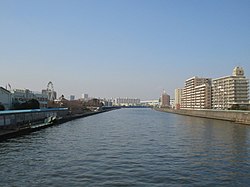Sumida River: Difference between revisions
Appearance
Content deleted Content added
No edit summary |
No edit summary |
||
| Line 10: | Line 10: | ||
* [[Adachi-ku, Tokyo|Adachi]] |
* [[Adachi-ku, Tokyo|Adachi]] |
||
* [[Arakawa, Tokyo|Arakawa]] |
* [[Arakawa, Tokyo|Arakawa]] |
||
| ⚫ | |||
* [[Sumida, Tokyo|Sumida]] |
* [[Sumida, Tokyo|Sumida]] |
||
* [[Taito, Tokyo|Taito]] |
* [[Taito, Tokyo|Taito]] |
||
* [[Koto, Tokyo|Koto]] |
* [[Koto, Tokyo|Koto]] |
||
* [[Chuo, Tokyo|Chuo]] |
* [[Chuo, Tokyo|Chuo]] |
||
| ⚫ | |||
==Culture== |
==Culture== |
||
Revision as of 13:29, 13 June 2007


The Sumida River (隅田川, Sumida-gawa) is a river which flows through Tokyo, Japan. It branches from the Arakawa River at Iwabuchi and flows into Tokyo Bay. Its tributaries include the Kanda and Shakujii rivers.
What is now known as the "Sumida River" was previously the path of the Arakawa, however towards the end of the Meiji era work was carried out to divert the main flow of the Arakawa to prevent flooding.
It passes through the following wards of Tokyo:

Culture
The noh play Sumidagawa, which the British composer Benjamin Britten saw while visiting Japan in 1956, inspired him to compose Curlew River (1964), a dramatic work based on the story.
Wikimedia Commons has media related to Category:Sumida River.
